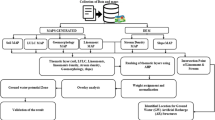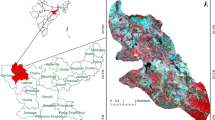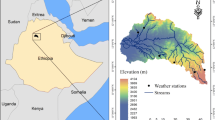Abstract
Understanding natural phenomena with the help of modern scientific approaches helps to reach sustainable solutions for current and future water-related problems. In this context, present study aims to assess relative influencing level of physical factors in controlling groundwater level, using a novel grid-based delineation technique, in Lower Palar River Basin, in Kanchipuram and Chengalpattu districts of South India. The influencing factors viz-a-viz: rainfall, soil texture, land use/land cover, terrain slope, geomorphology, lithology, and drainage characteristics were considered for the study. Archived data (2011 to 2020) of monthly rainfall at four rain gauge stations and monthly groundwater level of 22 locations, soil texture, lithology, and geomorphology data were considered for the study. SRTM digital elevation model with 30-m resolution was used for analyzing drainage characteristics and terrain slope. Thematic maps for considered factors were prepared, using common grid delineation method in GIS platform that divided study area into 52 grids, to inter-relate the discrete and continuous parameters with groundwater level. Results indicate that level of influence increases in the order of precipitation followed by lithology, land use/land cover, terrain slope, geomorphology, infiltration number, and soil texture. The study shows groundwater resilience is highly influenced by soil texture and infiltration number compared to other factors considered. It can be concluded that grid-based delineation successfully identifies grids with significant influence of individual factors by comparing with groundwater resilience. Common grid-based delineation method proves to be more effective in assessing groundwater resilience and can be used more efficiently in groundwater studies.







Similar content being viewed by others
Data availability
Data will be provided on request.
References
Abijith, D., Saravanan, S., Singh, L., Jennifer, J. J., Saranya, T., & Parthasarathy, K. S. S. (2020). GIS-based multi-criteria analysis for identification of potential groundwater recharge zones - A case study from Ponnaniyaru watershed, Tamil Nadu, India. HydroResearch, 3(2020), 1–14.
Achu, A. L., Reghunath, R., & Thomas, J. (2020). Mapping of groundwater recharge potential zones and identification of suitable site-specific recharge mechanisms in a tropical river basin. Earth Systems and Environment, 4(1), 131–145. https://doi.org/10.1007/s41748-019-00138-5
Agarwal, E., Agarwal, R., Garg, R. D., & Garg, P. K., et al. (2013). Delineation of groundwater potential zone: An AHP/ANP approach. Journal of Earth System Science, 122(3), 887–898.
Agassi, M., Morin, J., & Shainberg, I. (1982). Laboratory studies of infiltration and runoff control in semi-arid soils in Israel. Geoderma, 28(3–4), 345–356. https://doi.org/10.1016/0016-7061(82)90009-X
Ahmed, S. A., Chandrashekarappa, K. N., Raj, S. K., Nischitha, V., & Kavitha, G. (2010). Evaluation of morphometric parameters derived from ASTER and SRTM DEM—A study on Bandihole Sub-watershed Basin in Karnataka. Journal of the Indian Society of Remote Sensing, 38(2), 227–238. https://doi.org/10.1007/s12524-010-0029-3
Ahuja, R., & Kishore, N. (2020). Analysis of watershed characteristics of Nalagarh watershed, Himachal Pradesh for optimization of recharge structures and management of groundwater. Nature Environment and Pollution Technology, 19(4), 1411–1421. https://doi.org/10.46488/NEPT.2020.v19i04.007
Al-Ozeer, A. Z., Abdaki, M. A., Al-Iraqi, A. R., Al-Samman, S. H., & Al-Hammadi, N. A. (2020). Estimation of mean areal rainfall and missing data by using GIS in Nineveh, Northern Iraq. The Iraqi Geological Journal, 53(1), 93–103. https://doi.org/10.46717/IGJ.53.1E.7RY-2020-07.07
Amanambu, A. C., Obarein, O. A., Mossa, J., Li, L., Ayeni, S. S., Balogun, O., Oyebamiji, A., & Ochege, F. U. (2020). Groundwater system and climate change: Present status and future considerations. In Journal of Hydrology (Vol. 589). Elsevier B.V. https://doi.org/10.1016/j.jhydrol.2020.125163
Arefin, R. (2020)- Arefin R (2020) Groundwater potential zone identification at Plio-Pleistocene elevated tract, Bangladesh: AHP-GIS and remote sensing approach. Groundwater for Sustainable Development 10. https://doi.org/10.1016/j.gsd.2020.100340
Arulbalaji, P., & Gurugnanam, B. (2017). Geospatial tool-based morphometric analysis using SRTM data in Sarabanga Watershed, Cauvery River, Salem district, Tamil Nadu, India. Applied Water Science, 7(7), 3875–3883. https://doi.org/10.1007/S13201-017-0539-Z/TABLES/2
Baghdadi, N., Mallet, C., & Zribi, M. (2018). QGIS and applications in agriculture and forest. QGIS and Applications in Agriculture and Forest, 2, 1–350. https://doi.org/10.1002/9781119457107
Banerjee, D., & Ganguly, S. (2023). A review on the research advances in groundwater–surface water interaction with an overview of the phenomenon. Water. https://doi.org/10.3390/w15081552,15,8,(1552)
Bhat, N. A., & Jeelani, G. (2018). Quantification of groundwater–surface water interactions using environmental isotopes: A case study of Bringi Watershed, Kashmir Himalayas, India. Journal of Earth System Science, 127(5). https://doi.org/10.1007/s12040-018-0964-x
Bourjila, A., Dimane, F., Ouarghi, H. E., Nouayti, N., Taher, M., EL Hammoudani, Y., Saadi, O., & Bensiali, A. (2021). Groundwater potential zones mapping by applying GIS, remote sensing and multi-criteria decision analysis in the Ghiss basin, northern Morocco. Groundwater for Sustainable Development, 15. https://doi.org/10.1016/j.gsd.2021.100693
Cambraia Neto, A. J., & Rodrigues, L. N. (2020). Evaluation of groundwater recharge estimation methods in a watershed in the Brazilian Savannah. Environmental Earth Sciences, 79(6). https://doi.org/10.1007/s12665-020-8884-x
Chu, S. T. (1978). Infiltration during an unsteady rain. Water Resources Research, 14(3), 461–466. https://doi.org/10.1029/WR014I003P00461
Congedo, L. (2021). Semi-automatic classification plugin: A Python tool for the download and processing of remote sensing images in QGIS. Journal of Open Source Software, 6(64), 3172. https://doi.org/10.21105/joss.03172
Cuthbert, M., Taylor, R., Favreau, G. 2019 Observed controls on resilience of groundwater to climate variability in sub-Saharan Africa. Nature.Com. Retrieved March 24, 2023, from https://www.nature.com/articles/s41586-019-1441-7
Das, N., & Mukhopadhyay, S. (2020). Application of multi-criteria decision making technique for the assessment of groundwater potential zones: A study on Birbhum district, West Bengal, India. Environment, Development and Sustainability, 22, 931–955.
Doke, A. B., Zolekar, R. B., Patel, H., & Das, S. (2021). Geospatial mapping of groundwater potential zones using multi-criteria decision-making AHP approach in a hardrock basaltic terrain in India. Ecological Indicators, 127, 107685.
Ghosh, M., & Gope, D. (2021). Hydro-morphometric characterization and prioritization of sub-watersheds for land and water resource management using fuzzy analytical hierarchical process (FAHP): a case study of upper Rihand watershed of Chhattisgarh State, India. Applied Water Science, 11(2). https://doi.org/10.1007/s13201-020-01340-x
Ghosh, P. K., Bandyopadhyay, S., & Jana, N. C. (2016). Mapping of groundwater potential zones in hard rock terrain using geoinformatics: A case of Kumari watershed in western part of West Bengal. Modeling Earth Systems and Environment, 2(1). https://doi.org/10.1007/s40808-015-0044-z
Goni, I. B., Taylor, R. G., Favreau, G., Shamsudduha, M., Nazoumou, Y., & NgounouNgatcha, B. (2021). Groundwater recharge from heavy rainfall in the southwestern Lake Chad Basin: Evidence from isotopic observations. Hydrological Sciences Journal, 66(8), 1359–1371. https://doi.org/10.1080/02626667.2021.1937630
Gorelick, S. M., & Zheng, C. (2015). Global change and the groundwater management challenge. Water Resources Research, 51(5), 3031–3051. https://doi.org/10.1002/2014WR016825
Harsha, J., Ravikumar, A. S., & Shivakumar, B. L. (2020). Evaluation of morphometric parameters and hypsometric curve of Arkavathy river basin using RS and GIS techniques. Applied Water. Science, 10(3). https://doi.org/10.1007/S13201-020-1164-9
Huntington, J., & Niswonger, R. G. (2012). Role of surface-water and groundwater interactions on projected summertime streamflow in snow dominated regions: An integrated modeling approach. Water Resources Research, 48(11). https://doi.org/10.1029/2012WR012319
Hussain, F., Wu, R. S., & Shih, D. S. (2022). Water table response to rainfall and groundwater simulation using physics-based numerical model: WASH123D. Journal of Hydrology: Regional Studies, 39. https://doi.org/10.1016/j.ejrh.2022.100988
IS 4986 (2002) Installation of rain gauge (non-recording type) and measurement of Rain - Code of Practice, 2nd revision, (pp. 17). New Delhi: Bureau of Indian Standars.
Jain, S. K., Agarwal, P. K., & Singh, V. P. (2007). River basins of India. Hydrology and Water Resources of India, 297–331. https://doi.org/10.1007/1-4020-5180-8_7
Jena, S., Panda, R. K., Ramadas, M., Mohanty, B. P., & Pattanaik, S. K. (2020). Delineation of groundwater storage and recharge potential zones using RS-GIS-AHP: Application in arable land expansion. Remote Sensing Applications: Society and Environment, 19, 100354.
Kumar, M., Singh, P., & Singh, P. (2022). Integrating GIS and remote sensing for delineation of groundwater potential zones in Bundelkhand Region, India. Egyptian Journal of Remote Sensing and Space Science, 25(2), 387–404. https://doi.org/10.1016/j.ejrs.2022.03.003
Kumar, S., Venkatesh, A. S., Singh, R., Udayabhanu, G., & Saha, D. (2018). Geochemical signatures and isotopic systematics constraining dynamics of fluoride contamination in groundwater across Jamui district, Indo-Gangetic alluvial plains, India. Chemosphere, 205, 493–505. https://doi.org/10.1016/j.chemosphere.2018.04.116
Leroux, L., Congedo, L., Bellón, B., Gaetano, R., & Bégué, A. (2018). Land cover mapping using Sentinel-2 images and the semi-automatic classification plugin: A Northern Burkina Faso case study. QGIS and Applications in Agriculture and Forest, 2, 119–151. https://doi.org/10.1002/9781119457107.CH4
Ma, W., Zhang, X., Zhen, Q., & Zhang, Y. (2016). Effect of soil texture on water infiltration in semiarid reclaimed land. Water Quality Research Journal, 51(1), 33–41. https://doi.org/10.2166/WQRJC.2015.025
Maity, D. K., & Mandal, S. (2019). Identification of groundwater potential zones of the Kumari riverbasin, India: an RS & GIS based semi-quantitative approach. Environment, Development and Sustainability, 21, 1013–1034. https://doi.org/10.1007/s10668-017-0072-0
Mogaji, K. A., Lim, H. S., & Abdullah, K. (2015). Regional prediction of groundwater potential mapping in a multifaceted geology terrain using GIS-based Dempster-Shafer model. Arabian Journal of Geosciences, 8, 3235–3258. https://doi.org/10.1007/s12517-014-1391-1
Moghaddasi, P., Kerachian, R., Hydrology, S. S.-J. of, & 2022, A stakeholder-based framework for improving the resilience of groundwater resources in arid regions. Elsevier. Retrieved March 24, 2023, from https://www.sciencedirect.com/science/article/pii/S0022169422003122
Moodley, T., Seyam, M., Abunama, T., & Bux, F. (2022). Delineation of groundwater potential zones in KwaZulu-Natal, South Africa using remote sensing, GIS and AHP. Journal of African Earth Sciences, 193. https://doi.org/10.1016/j.jafrearsci.2022.104571
Mukherjee, I., & Singh, U. K. (2020). Delineation of groundwater potential zones in adrought-prone semi-arid region of east India using GIS and analytical hierarchical process techniques. Catena, 194. https://doi.org/10.1016/j.catena.2020.104681
Nithya, C. N., Srinivas, Y., Magesh, N. S., & Kaliraj, S. (2019). Assessment of groundwater potential zones in Chittar basin, Southern India using GIS based AHP technique. Remote Sensing Applications: Society and Environment, 15, 100248. https://doi.org/10.1016/J.RSASE.2019.100248
Noori, A. R., & Singh, S. K. (2021). Spatial and temporal trend analysis of groundwater levels and regional groundwater drought assessment of Kabul, Afghanistan. Environmental Earth Sciences, 80(20). https://doi.org/10.1007/S12665-021-10005-0
Patra, S., Mishra, P., & Mahapatra, S. C. (2018). Delineation of groundwater potential zone for sustainable development: A case study from Ganga Alluvial Plain covering Hooghly district of India using remote sensing, geographic information system and analytic hierarchy process. Journal of Cleaner Production, 172, 2485–2502. https://doi.org/10.1016/J.JCLEPRO.2017.11.161
Raju, R. S., Raju, G. S., & Rajasekhar, M. (2019). Identification of groundwater potential zones in Mandavi River basin, Andhra Pradesh, India using remote sensing. GIS and MIF techniques. HydroResearch, 2(2019), 1–11.
Roy, P. K., Roy, S. S., Giri, A., Banerjee, G., Majumder, A., & Mazumdar, A. (2015). Study of impact on surface water and groundwater around flow fields due to changes in river stage using groundwater modeling system. Clean Technologies and Environmental Policy, 17(1), 145–154. https://doi.org/10.1007/s10098-014-0769-9
Sajil Kumar, P. J., Elango, L., & Schneider, M. (2022). GIS and AHP based groundwater potential zones delineation in Chennai River Basin (CRB), India. Sustainability (Switzerland), 14(3), 1830. https://doi.org/10.3390/su14031830
Samani, S., & Kardan Moghaddam, H. (2022). Optimizing groundwater level monitoring networks with hydrogeological complexity and grid-based mapping methods. Environmental Earth Sciences, 81(18). https://doi.org/10.1007/s12665-022-10569-5
Sampathkumar, K. M., Ramasamy, S., Ramasubbu, B., Karuppanan, S., & Lakshminarayanan, B. (2021). Hybrid optimization model for conjunctive use of surface and groundwater resources in water deficit irrigation system. Water Science and Technology, 84(10–11), 3055–3071. https://doi.org/10.2166/wst.2021.279
Saravanan, K., Srinivasamoorthy, K., Gopinath, S., Prakash, R., Suma, C. S., Vinnarasi, J., & Ponnumani, G. (2018). Geochemical evolution of groundwater along flow path in Upper Vellar sub basin, Tamilnadu, India: an integrated approach using hydrochemistry, modeling and statistical techniques. Modeling Earth Systems and Environment, 4(2), 647–658. https://doi.org/10.1007/s40808-017-0400-2
Saravanan, S., Saranya, T., Abijith, D., Jacinth, J. J., & Singh, L. (2021). Delineation of groundwater potential zones for Arkavathi sub-watershed, Karnataka, India using remote sensing and GIS. Environmental Challenges, 5. https://doi.org/10.1016/j.envc.2021.100380
Sreedevi, P. D., Owais, S., Khan, H. H., & Ahmed, S. (2009). Morphometric analysis of a watershed of South India using SRTM data and GIS. Journal of the Geological Society of India, 73(4), 543–552. https://doi.org/10.1007/s12594-009-0038-4
Tani, H., & Tayfur, G. (2021). Identification of groundwater potential zones in Kabul River Basin. Afghanistan. Groundwater for Sustainable Development, 15. https://doi.org/10.1016/j.gsd.2021.100666
TN-IAWARM. (2019). TN-IAMWARM Project Palar Sub Basin Water Resources Department detailed project report. Government of Tamil Nadu.
Wang, Y., & Chen, N. (2021). Recent progress in coupled surface–ground water models and their potential in watershed hydro-biogeochemical studies: A review. Watershed Ecology and the Environment, 3, 17–29. https://doi.org/10.1016/j.wsee.2021.04.001
Wang, Y., Zechner, M., Mern, J. M., Kochenderfer, M. J., & Caers, J. K. (2022). A sequential decision-making framework with uncertainty quantification for groundwater management. Advances in Water Resources, 166, 104266. https://doi.org/10.1016/J.ADVWATRES.2022.104266
Winter, T. C. (1995). Recent advances in understanding the interaction of groundwater and surface water. Reviews of Geophysics, 33(2 S), 985–994. https://doi.org/10.1029/95RG00115
Yadav, B., Malav, L. C., Jangir, A., Kharia, S. K., Singh, S. V., Yeasin, M., Nogiya, M., Meena, R. L., Meena, R. S., Tailor, B. L., Mina, B. L., Alhar, M. S. O., Jeon, B. H., Cabral-Pinto, M. M. S., & Yadav, K. K. (2023). Application of analytical hierarchical process, multi-influencing factor, and geospatial techniques for groundwater potential zonation in a semi-arid region of western India. Journal of Contaminant Hydrology, 253. https://doi.org/10.1016/j.jconhyd.2022.104122
Yeh, H. F., Lee, C. H., Hsu, K. C., & Chang, P. H. (2009). GIS for the assessment of the groundwater recharge potential zone. Environmental Geology, 58(1), 185–195. https://doi.org/10.1007/S00254-008-1504-9
Yuqiong, H., Rong, S., Zemin, X., & Weijia, T. (2021). The dynamic change and effect of rainfall induced groundwater flow. Water. https://doi.org/10.3390/w13192625
Acknowledgements
NS thanks Dean CET, Dean of Research, and Management of SRMIST for their support in the form of a fellowship for his Ph.D. Programme. The authors acknowledge the Public Works Department, Government of Tamil Nadu, for providing the necessary data.
Author information
Authors and Affiliations
Contributions
NS and PP conceived the idea. NS procured the data for the study area. The data processed and analyzed by NS. Study was supervised and results were validated by PP. NS and PP carried out data interpretation and manuscript preparation. PP was also involved in the revision and finalization of the manuscript.
Corresponding author
Ethics declarations
Conflict of interest
The authors declare no competing interests.
Additional information
Publisher’s Note
Springer Nature remains neutral with regard to jurisdictional claims in published maps and institutional affiliations.
Highlights
• Novel grid-based geospatial analysis was done.
• The grid-based study is an efficient tool to identify influencing factors of GWL.
• Soil texture and morphometric parameters have more impact on groundwater level (GWL).
• Rainfall and slope have relatively less effect on GWL of flat terrain.
Rights and permissions
Springer Nature or its licensor (e.g. a society or other partner) holds exclusive rights to this article under a publishing agreement with the author(s) or other rightsholder(s); author self-archiving of the accepted manuscript version of this article is solely governed by the terms of such publishing agreement and applicable law.
About this article
Cite this article
Nagaraj, S., Purushothaman, P. Assessment of influencing level of rainfall and physical factors on groundwater level for a semi-arid flat terrain watershed using grid-based geospatial analysis: a case study from Lower Palar Basin, Tamil Nadu, India. Environ Monit Assess 195, 1159 (2023). https://doi.org/10.1007/s10661-023-11805-6
Received:
Accepted:
Published:
DOI: https://doi.org/10.1007/s10661-023-11805-6




